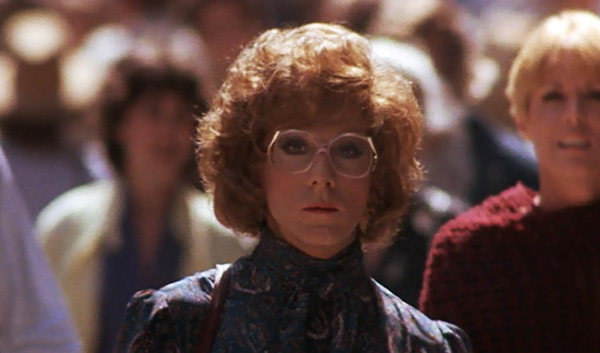A farcical premise with a screwball tone, Tootsie proceeds to engage with the expected dual-identity tropes and themes that preceded and came after it. Michael as Dorothy has close calls with unsuspecting coworkers, and he’s given access to female spaces. Men that are attracted to her have to be let down easy. Some of this is retrograde for modern audiences, but just like with the meta angle of Hoffman himself, Tootsie sidesteps controversy by acknowledging how absurd workplace sexism can be. A grabby co-star (George Gaynes) isn’t turned down by his female costars when he makes a habit of leaning in for ‘friendly’ kisses, but Dorothy angrily rejects him. Whether this happens because of gay panic or because of taking offense at the co-star’s aggression, Dorothy’s rejection of him allows the other women to do the same. Michael also learns just how much work women have to put into their daily appearance, and though Dorothy passes, she’s only considered attractive by men in their 60’s. The work of being a conventionally attractive woman seems so strenuous as to be unimaginable.
The period of Tootsie’s release, when women have achieved a series of legal victories but the cultural equivalent is more piecemeal, provides more interesting paths into the film. The only creative female force behind the camera is Elaine May as an uncredited writer, and that’s one more creative female force than is shown on Dorothy’s soap opera. Absurd plotlines on the hospital-set show include scenes that require Dorothy to counsel a battered wife to be more understanding of her husband. Instead, Dorothy improvs an ass-kicking of the abusive man. The same thing happens when her character is asked to help the female staff on the show adapt to sexual harassment from the doctors. That a team of male writers could be so clueless as to write these kinds of scenes seems exactly right, but Tootsie still requires a man to be the one to say so. This film represents a step in the right direction, towards an evolving and empathetic critical eye, but it does so at the exclusion of women. Tootsie’s a journey and not the end destination.
A romantic angle that develops between Michael and fellow actor Julie (Jessica Lange) leans into the film’s farcical element and detracts from the broader satire. Primarily a third act development, this doomed relationship pushes the film towards its conclusion. Michael wrestles pointlessly with how to square his desire for Julie with her growing friendship with Dorothy, and it’s a no-win scenario for the characters and the viewer. The burgeoning female friendship is played straight by Lange and Pollack, with her earnestly desirous of time and honesty with what she considers to be an older woman who could be a mentor. It almost overtakes Michael’s romantic interest, but there’s simply no way for an early 80’s film to ignore the possibility of their getting together. Lange won an Oscar for this role and it’s likely because of how she gets so close to making the viewer forget that she’s speaking to a man in drag. Less successful is Garr’s Sandy, who becomes the Michael to his Julie. She wants to be in a relationship with him, but he’s not interested at all, and the role is exasperated flibbertigibbet instead of anything real.
Tootsie provokes a lot of thought about its place in history. There have been plenty of execrable cross-dressing comedies in the years since, and it’s certainly wig and shoulder-pads above those. Thanks to its rapid-fire dialogue and brisk editing, it’s also comedically dense in a way that presages show-business comedies like 30 Rock, whose central character owned a single DVD and this was it. If it’s good enough for Liz Lemon, it’s good enough for me. The ick factor around Hoffman can’t be scrubbed off of it, but that cut to the first look at Dorothy is an all-timer. B+

 RSS Feed
RSS Feed